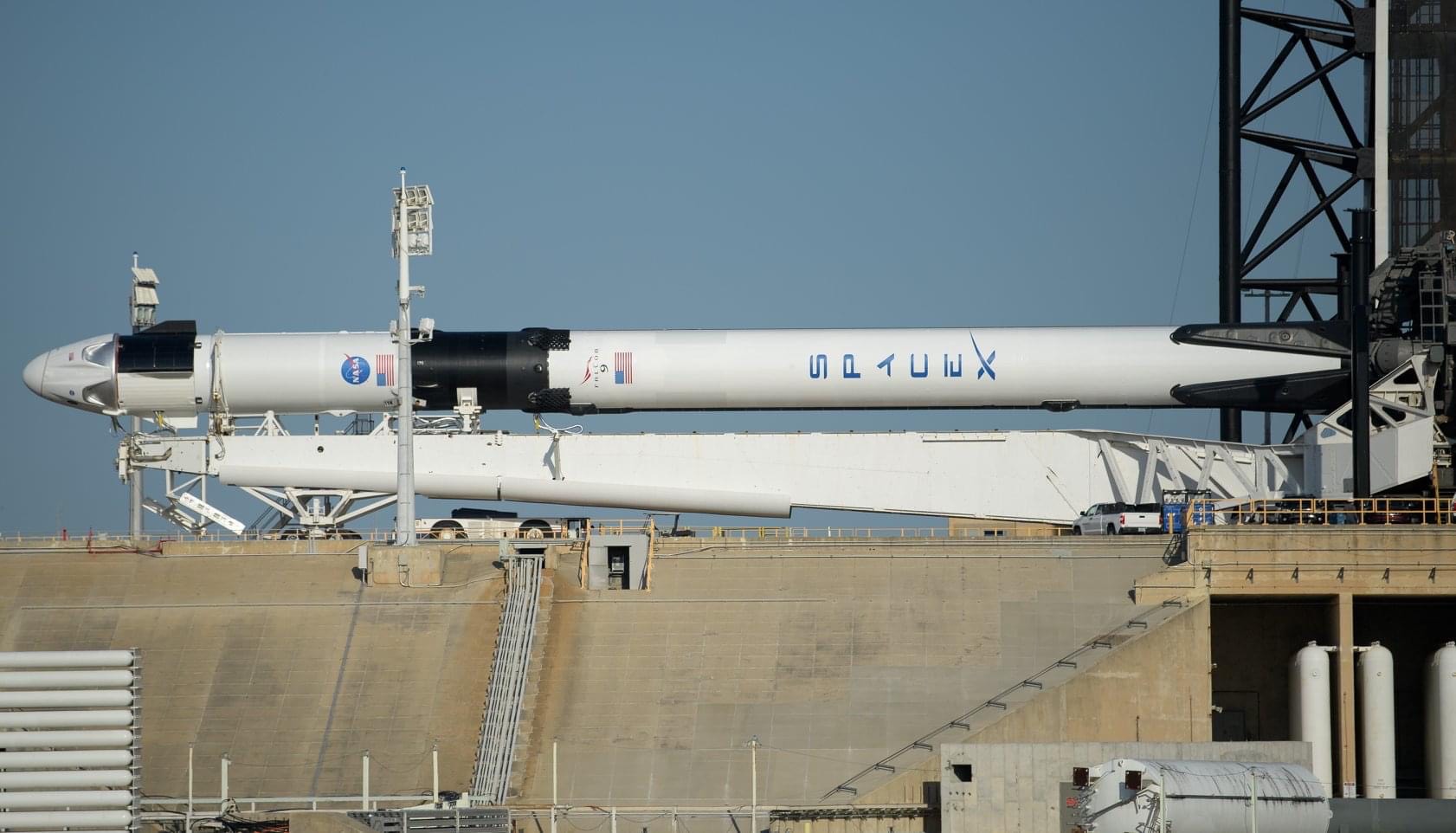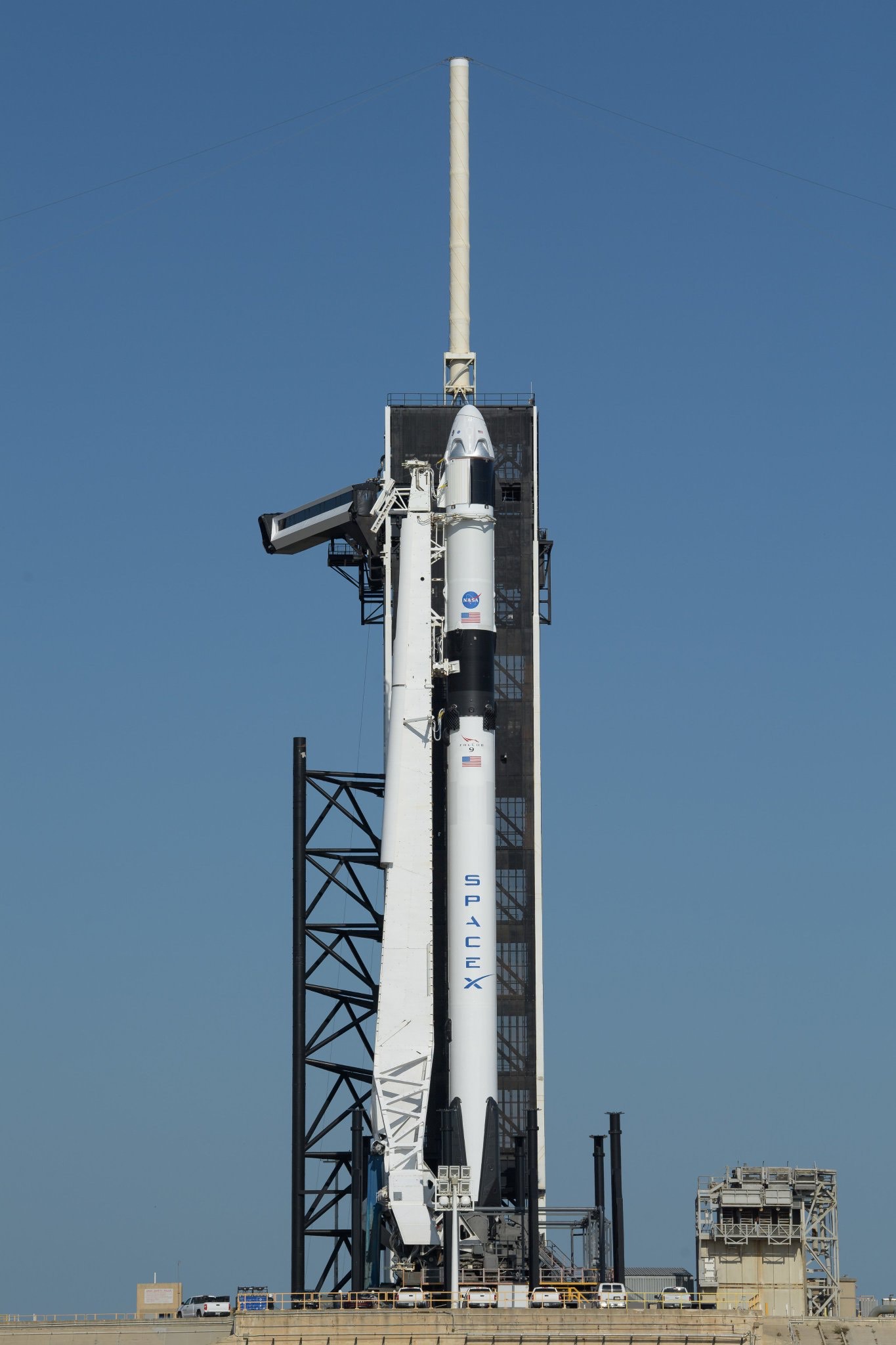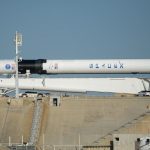

News
SpaceX Crew Dragon has made its way to the launch pad (Photos)
SpaceX’s Crew Dragon spacecraft and its Falcon 9 launcher rolled to the launch pad on May 21. A few hours later, the rocket went vertical, standing 215 feet tall on its perch atop Pad 39A. From here, SpaceX will conduct a static fire test of the rocket’s main engines on Friday, May 22.
During that test, which is a part of SpaceX’s routine pre-launch preparations, the rocket will be fueled and held in place as the nine Merlin 1D engines are briefly fired. This allows engineers to assess the booster’s performance and ensure all systems are working as they should.
The Falcon 9 rocket starring in this historic mission is a brand new booster, never flown before. For its inaugural flight, the rocket will ferry two NASA astronauts — Bob Behnken and Doug Hurley — into space, where they will sync up with the International Space Station just 19 hours after launch.
- The Falcon arrived at the top of the pad and proceeded to go vertical around 9 am on May 21. Credit: NASA
- The Falcon 9 left the hangar at Pad 39A early in the morning on May 21. Credit: NASA
Agency officials, together with SpaceX are conducting an analysis of the vehicle’s ability to fly people safely. Called a Flight Readiness Review, the meeting it essentially the final major hurdle before the launch can proceed.
The day-long meeting is held at NASA’s Kennedy Space Center and will be lead by NASA’s associate administrator, Steve Jurczyk. Doug Loverro, the agency’s associate administrator for the human exploration program was supposed to host, but he tendered his resignation on May 18.
Many were concerned his abrupt departure may have something to do with the crew mission, but that does not appear to be the case based on comments from Loverro. In a report by the Washington Post, Loverro said told the Post that his departure had nothing to do with commercial crew, but instead was related to the Artemis moon program.

Still, that didn’t stop Congress from raising an eyebrow at the timing of it all.
Despite the shuffle in leadership, NASA and SpaceX are pressing forward with the launch, and are expected to hold a press conference later this evening (May 21) to discuss the results of the Flight Readiness Review.
In the meantime, it’s business as usual at the launch pad. The vehicle is standing tall and engineers are prepping it for the week’s upcoming activities, which include one final dress rehearsal with the crew.
That just leaves the final launch readiness review on Monday, May 25, followed by the launch two days later.
This is the third time in history that a brand new vehicle has stood poised to launch atop this very pad. 39A previously hosted NASA’s Apollo moon missions, as well as the bulk of the shuttle missions. Now, another brand new vehicle will carry humans for the first time. Lifting off at 4:33 pm EDT (2033 UTC), the Crew Dragon spacecraft will make history as it ushers in a new era of human spaceflight — one where commercial companies are leading the way.

News
Tesla starts showing how FSD will change lives in Europe
Local officials tested the system on narrow country roads and were impressed by FSD’s smooth, human-like driving, with some calling the service a game-changer for everyday life in areas that are far from urban centers.

Tesla has launched Europe’s first public shuttle service using Full Self-Driving (Supervised) in the rural Eifelkreis Bitburg-Prüm region of Germany, demonstrating how the technology can restore independence and mobility for people who struggle with limited transport options.
Local officials tested the system on narrow country roads and were impressed by FSD’s smooth, human-like driving, with some calling the service a game-changer for everyday life in areas that are far from urban centers.
Officials see real impact on rural residents
Arzfeld Mayor Johannes Kuhl and District Administrator Andreas Kruppert personally tested the Tesla shuttle service. This allowed them to see just how well FSD navigated winding lanes and rural roads confidently. Kruppert said, “Autonomous driving sounds like science fiction to many, but we simply see here that it works totally well in rural regions too.” Kuhl, for his part, also noted that FSD “feels like a very experienced driver.”
The pilot complements the area’s “Citizen Bus” program, which provides on-demand rides for elderly residents who can no longer drive themselves. Tesla Europe shared a video of a demonstration of the service, highlighting how FSD gives people their freedom back, even in places where public transport is not as prevalent.
What the Ministry for Economic Affairs and Transport says
Rhineland-Palatinate’s Minister Daniela Schmitt supported the project, praising the collaboration that made this “first of its kind in Europe” possible. As per the ministry, the rural rollout for the service shows FSD’s potential beyond major cities, and it delivers tangible benefits like grocery runs, doctor visits, and social connections for isolated residents.
“Reliable and flexible mobility is especially vital in rural areas. With the launch of a shuttle service using self-driving vehicles (FSD supervised) by Tesla in the Eifelkreis Bitburg-Prüm, an innovative pilot project is now getting underway that complements local community bus services. It is the first project of its kind in Europe.
“The result is a real gain for rural mobility: greater accessibility, more flexibility and tangible benefits for everyday life. A strong signal for innovation, cooperation and future-oriented mobility beyond urban centers,” the ministry wrote in a LinkedIn post.
News
Tesla China quietly posts Robotaxi-related job listing
Tesla China is currently seeking a Low Voltage Electrical Engineer to work on circuit board design for the company’s autonomous vehicles.

Tesla has posted a new job listing in Shanghai explicitly tied to its Robotaxi program, fueling speculation that the company is preparing to launch its dedicated autonomous ride-hailing service in China.
As noted in the listing, Tesla China is currently seeking a Low Voltage Electrical Engineer to work on circuit board design for the company’s autonomous vehicles.
Robotaxi-specific role
The listing, which was shared on social media platform X by industry watcher @tslaming, suggested that Tesla China is looking to fill the role urgently. The job listing itself specifically mentions that the person hired for the role will be working on the Low Voltage Hardware team, which would design the circuit boards that would serve as the nervous system of the Robotaxi.
Key tasks for the role, as indicated in the job listing, include collaboration with PCB layout, firmware, mechanical, program management, and validation teams, among other responsibilities. The role is based in Shanghai.
China Robotaxi launch
China represents a massive potential market for robotaxis, with its dense urban centers and supportive policies in select cities. Tesla has limited permission to roll out FSD in the country, though despite this, its vehicles have been hailed as among the best in the market when it comes to autonomous features. So far, at least, it appears that China supports Tesla’s FSD and Robotaxi rollout.
This was hinted at in November, when Tesla brought the Cybercab to the 8th China International Import Expo (CIIE) in Shanghai, marking the first time that the autonomous two-seater was brought to the Asia-Pacific region. The vehicle, despite not having a release date in China, received a significant amount of interest among the event’s attendees.
Elon Musk
Elon Musk and Tesla AI Director share insights after empty driver seat Robotaxi rides
The executives’ unoccupied tests hint at the rapid progress of Tesla’s unsupervised Robotaxi efforts.

Tesla CEO Elon Musk and AI Director Ashok Elluswamy celebrated Christmas Eve by sharing personal experiences with Robotaxi vehicles that had no safety monitor or occupant in the driver’s seat. Musk described the system’s “perfect driving” around Austin, while Elluswamy posted video from the back seat, calling it “an amazing experience.”
The executives’ unoccupied tests hint at the rapid progress of Tesla’s unsupervised Robotaxi efforts.
Elon and Ashok’s firsthand Robotaxi insights
Prior to Musk and the Tesla AI Director’s posts, sightings of unmanned Teslas navigating public roads were widely shared on social media. One such vehicle was spotted in Austin, Texas, which Elon Musk acknowleged by stating that “Testing is underway with no occupants in the car.”
Based on his Christmas Eve post, Musk seemed to have tested an unmanned Tesla himself. “A Tesla with no safety monitor in the car and me sitting in the passenger seat took me all around Austin on Sunday with perfect driving,” Musk wrote in his post.
Elluswamy responded with a 2-minute video showing himself in the rear of an unmanned Tesla. The video featured the vehicle’s empty front seats, as well as its smooth handling through real-world traffic. He captioned his video with the words, “It’s an amazing experience!”
Towards Unsupervised operations
During an xAI Hackathon earlier this month, Elon Musk mentioned that Tesla owed be removing Safety Monitors from its Robotaxis in Austin in just three weeks. “Unsupervised is pretty much solved at this point. So there will be Tesla Robotaxis operating in Austin with no one in them. Not even anyone in the passenger seat in about three weeks,” he said. Musk echoed similar estimates at the 2025 Annual Shareholder Meeting and the Q3 2025 earnings call.
Considering the insights that were posted Musk and Elluswamy, it does appear that Tesla is working hard towards operating its Robotaxis with no safety monitors. This is quite impressive considering that the service was launched just earlier this year.










